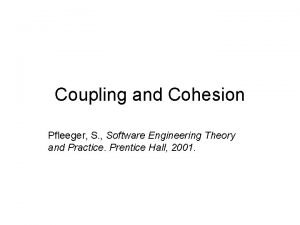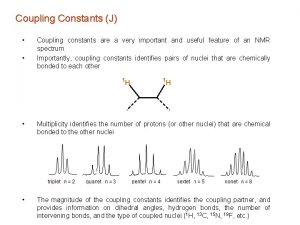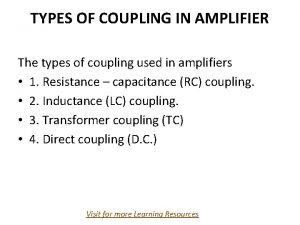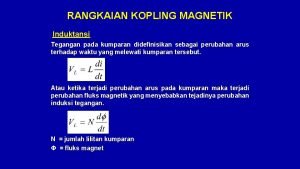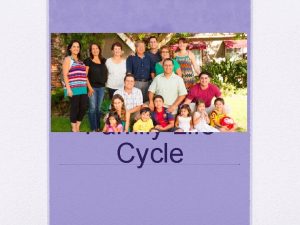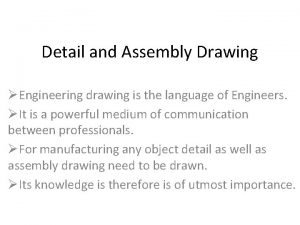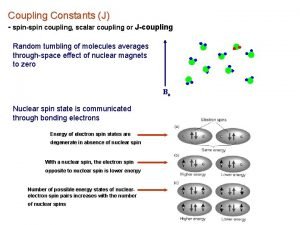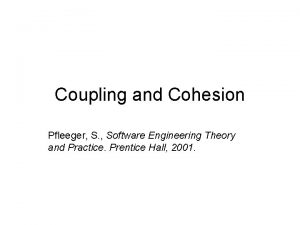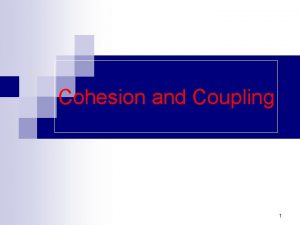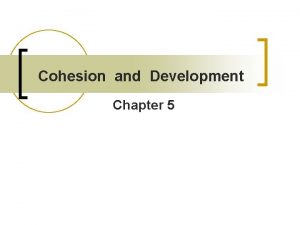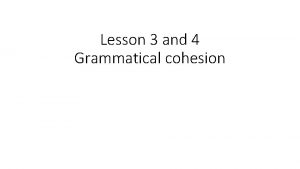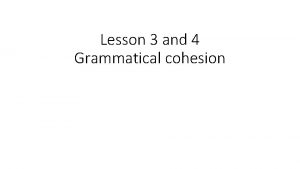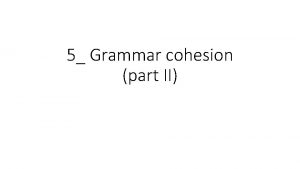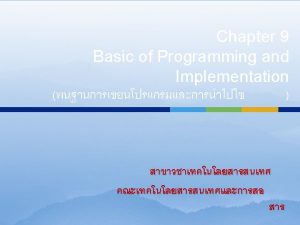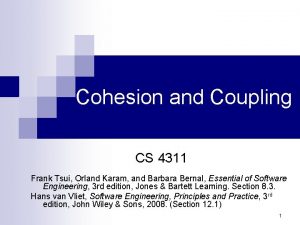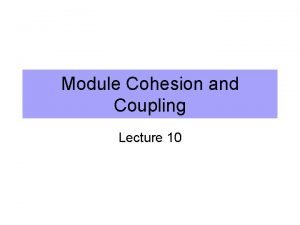6 Cohesion and Coupling What are the challenges





























- Slides: 29

6. Cohesion and Coupling

What are the challenges of each? Knowing what the parts DO! • Finding the parts to change • Knowing what happens when you change them How they connect • Knowing how to put them back together again Change a diaper? Change a fuel filter?


• Component: a collection of responsibilities • • • Large numbers of responsibilities: difficult to understand Small number, closely related: much easier to understand Classes with a small number of closely related responsibilities: cohesive True for methods, packages, etc. : want closely related responsibilities General goal for each component: high cohesion • Understanding relationships between classes • Interconnectivity between two classes: their coupling • High coupling: a change in one class means changes in the other • Goal: low coupling between components

Improving coupling, cohesion • How does the Adapter Pattern improve coupling, cohesion? • Lower coupling, no impact to cohesion • How does the Strategy Pattern improve coupling, cohesion? • Higher cohesion, but possibly higher coupling • What does the Singleton Pattern do to improve coupling, cohesion? • Lower coupling; if alternative is no class, higher cohesion • Note: • Adapter: structural pattern • Strategy: behavioral pattern • Singleton: creational pattern • Structural patterns are generally about reducing coupling

modularity

Coupling • Will look at coupling first • Reminder: a measure of interconnection between modules • Goal: low coupling • Simple connections between modules • Starting point: extremely coupled • Any small change will result in changes to the rest of the system

But is there a way to make this legal?

import java. lang. reflect. Field; # output class Student { private String first. Name = "Sampath"; Value of first. Name: Sampath } Value of first. Name after changing: Trisha public class Test. Reflection { public static void main(String args[]) throws Exception { Student some. Student = new Student(); Makes field accessible by both get, set Field fs = some. Student. get. Class(). get. Declared. Field("first. Name"); fs. set. Accessible(true); System. out. println("Value of " + fs. get. Name() + ": " + fs. get(some. Student)); fs. set(some. Student, "Trisha"); System. out. println("Value of " + fs. get. Name() + " after changing: " + fs. get(some. Student)); } } Consequences?


• Closely related to content coupling • Leaving data unrestricted; can access anywhere public class Student { public static String default. Name; public String first. Name; } • No real encapsulation – any code can change default, first. Name • Very challenging to identify which code modifies either • Known as “global variables” in other languages

package visibility!

Passing control information Note not used control coupling: information in one module dictates logic in another - often through a “flag”, a true/false variable used as a signal

Why is this a problem? • The logic is hard to follow • Little encapsulation – caller must know how the branching works • No names to tell you what’s happening; just need to know extra meanings • Cannot reuse components by themselves control coupling: information in one module dictates logic in another

• Frequent form: handle all errors • Seems consistent • Difficult to use • Impossible to reuse • Any change to control: revisit all calls Control Coupling: Not as bad as content, common coupling, but avoid

public class Image { … } public class Buffer { Image a, b; … } … void draw. Part. B(Buffer full) { … use just full. b



• coincidental cohesion: loose relationship between responsibilities • Example: putting all of your GUI code in a single form class • This was easy to do in Java Swing • The bee simulator sample code! • Example: Student. Financials. With. Courses. And. Residence • Hmm… how about “Student. Data”? • All of the clauses, especially “and” show this has too many responsibilities • problems: hard to maintain, hard to reuse such pieces • Solution for Student: associations to specialized classes • Student -- Schedule, Student -- Room -- Residence. Hall • Student -- Account


The sub-operations perform similar computations, but they are independent at all levels: • Domain level: e. g. , different files belong to different objects • Solution level: e. g. , different files are handled at different times in conjunction with different objects public class Event. Logger { public void log. Database. Error() { /* */ } public void log. File. Reading. Error() { /* */ } public void log. User. Input. Error() { /* */ } }

The sub-operations perform similar but independent computations. Watch out for this! This sort of organization is very tempting to engineers… “handle all of the errors in one place, ” etc.







 Antigentest åre
Antigentest åre Coupling in software design
Coupling in software design Difference between cohesion and coupling
Difference between cohesion and coupling Nmr principle
Nmr principle Geminal and vicinal coupling constants
Geminal and vicinal coupling constants Coupling constant nmr
Coupling constant nmr Geminal and vicinal coupling constants
Geminal and vicinal coupling constants What is ls and jj coupling
What is ls and jj coupling Ieee 519-2014
Ieee 519-2014 Different types of coupling in amplifiers
Different types of coupling in amplifiers Low coupling in software engineering
Low coupling in software engineering Real time fluoroscopy
Real time fluoroscopy Rangkaian kopling magnetik
Rangkaian kopling magnetik Half lap muff coupling drawing
Half lap muff coupling drawing Magnetic coupling in transformer
Magnetic coupling in transformer Linkage group in drosophila
Linkage group in drosophila Atra flex coupling distributors
Atra flex coupling distributors Atp cycle diagram
Atp cycle diagram Retirement stage of family life cycle
Retirement stage of family life cycle Outline assembly drawing
Outline assembly drawing Csc 205
Csc 205 Low coupling in software engineering
Low coupling in software engineering J coupling constant
J coupling constant Define coupling in software engineering
Define coupling in software engineering Safety breakaway coupling
Safety breakaway coupling Coupling vs repulsion
Coupling vs repulsion Atp and adp cycle
Atp and adp cycle Coupling vs repulsion
Coupling vs repulsion Cross frequency coupling
Cross frequency coupling Atra flex coupling insert
Atra flex coupling insert

